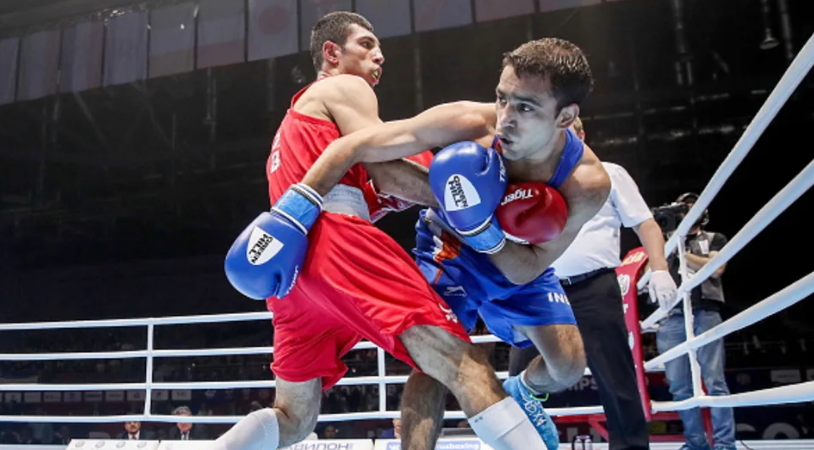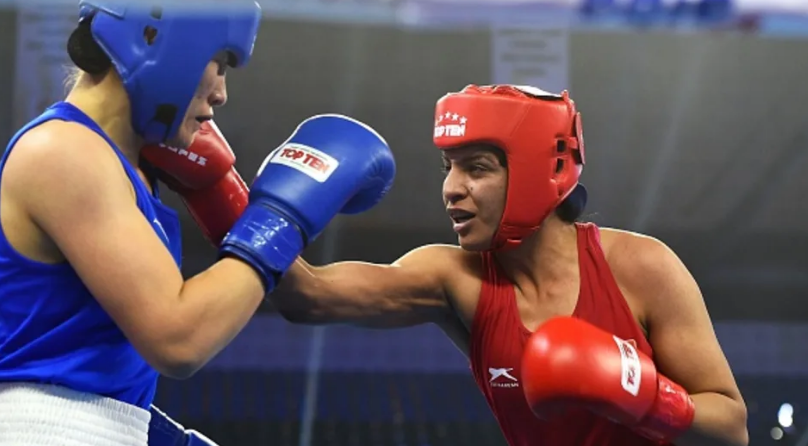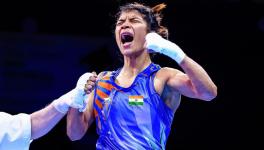Indian Boxing: After the High of Olympic Qualification, an Introspection

The way Amit Panghal lost to Hu Jianguan of China in the semifinal in Asia-Oceania Olympic qualifier Amman shows he is a bit straightjacketed strategy wise (Pics: Olympic Channel).
Indian boxers returned from the Asia-Oceania Olympic qualifiers in Amman, Jordan, after sealing quota berths in an unprecedented nine weight categories. They are under “self-quarantine” as we speak: the Coronavirus crisis spares no one. The performance of the boxers at the business end of the competition, requires a bit of quarantined introspection too. The fact that several of them suffered losses immediately after sealing qualification raises questions, dousing the euphoria around their qualification.
The Indian habit of excessive celebration post an Olympic qualification if and when that happens, in any sport, pushes out any scope of an objective analysis of where we stand. It is the quest for that rarity, an Olympic medal, one began thinking about after going through the qualifier results. There will be a full roster of Indian boxers in Tokyo, when and if the Games happen that is, increasing the chances of a medal ever so slightly. But, let’s hold that thought for a minute.
Our boxers, with their losses in the semifinals and finals of the qualifying tournament — let us also take into consideration that it was an Asian level competition — have left us with more doubts than solid assurances. I joined a couple of pugilistic old-timers to discuss the Indian performance in Amman, and something intriguing came up in the discussion: Longevity in boxing. As general a topic as it may sound, it may have a bearing in the performances of our boxers in Tokyo — specifically the two overwhelming medal prospects as per the consensus reached in our chat: Simranjit Kaur and Amit Panghal.
As is the established norm this side of the millenium in Indian boxing though, MC Mary Kom first. The boxer-turned-politician-turned boxer stands out as an aberration in any frame of reference, even among the elites of the ring. Shelf life of boxers is pretty limited. Then there is Mary and her two-decade long record-breaking career, spent mostly at the top rungs of her division. It shatters all known notions about longevity.
Also Read | IPL 2020 Postponed; Sports World On Hold Amidst Coronavirus Outbreak
Mary is a one-off, and her still-unfinished reign in the ring looks all the more glaring when the comparison is made with some of the Indian boxers who made it big on the global stage.
Vijender Singh, for instance. His peak lasted a bit above three years, from 2008 to 2011. Akhil Kumar, Jitender Kumar and Dinesh Kumar — contemporaries of Vijender — lasted more-or-less the same time. Remember Gaurav Bidhuri the sensation who burst onto the scene at the 2017 World Championships? He won bronze in his first major senior competition, got sidelined with injury, and has been struggling to make the cut into the national team since then. His peak on the world stage lasted substantially less than the Indian average of two-odd years.
V Devarajan, national selector and a World Cup bronze medallist from the 1990s, attributes Mary Kom’s dominance over generations of rival boxers to her versatility. But it all needs to be bound together by what the boxer protects within his or her guard, the bundles of neurons between the ears. “To start with, Mary doesn't have to prove anything to anyone any more,” he says. “So it is surprising when she talks as though her whole reputation is at stake if she doesn't win a medal in Tokyo. Then again, that's how boxing minds should tick. Boxers thrive on a constant supply of motivation. It could be from officials, it could be from coaches. It could and should come from within them too.”
And Mary possesses a lot of the latter. It is this self motivation that has pushed her to erratic and selfish acts, including the nasty episode against the much junior rival in the Indian set-up, Nikhat Zareen. But, beyond the episodes or her political allegiance, it remains a fact that Mary Kom, despite her age (she is 38 now) and a tad slower, is still right up there, among the best.
Much like Amit Panghal and Simranjit Kaur are at the moment. Simranjit is the upcoming, if not new, sensation. Her three big medals — the silver at the qualifiers, silver at the Asian championships and bronze at the World Championships last year — has pushed her stock up. But medals notwithstanding, it is the mix of qualities the 24-year-old possesses (something very rare in Indians) that makes her promising.
Simranjit is fast; She is powerful; She also has a fighting spirit that complements the first two. This makes her a complete package- almost. Sarita Devi, Mary Kom's contemporary and a co-flagbearer for Indian women’s boxing, acknowledged it soon after she was pounded out of reckoning during the national trials three months back. Simranjit fought a relentless attacking bout against Sarita. It wasn’t so much a voluntary change of guard as much as it was beaten in, with age, it is the inevitable message every athlete receives. The manner of delivery differs.
Simranjit conveyed it to Sarita emphatically. Then again, she seems to be trying to convey the same message to everyone she boxes against. It was evident in her bouts at the qualifiers, even in the final against South Korea's Oh Yeon-Ji.
The problem is, Simranjeet has a handicap. She can be a devastating boxer on the attack. But, despite being skillful all-round, she seems to have a mental block employing evasive tactics or being defensive in the ring — both necessary when facing world class opponents in the medal rounds. The block is highlighted by her medal tally on the international stage — bronzes and silvers. One needs to understand that in boxing, bronze is a default medal the puglisit gets assured of after reaching the semifinals. Bronze is bestowed after a losing cause in a medal round. Bronze or silver, especially, if they are the only medals a boxer seems to be winning, could, arguably, be taken as a sign that he or she is good enough to come through the early rounds, but lack something which blunts the edge in the prize fights. And boxing is all about the prize fight, isn't it?
Simranjit, at 24, is stepping out of the age bracket where she could be called a work in progress. Boxing old-timers would call her seasoned now, and she should have developed enough guile to score the important points in the ring when it matters. Battering opponents and conveying messages of dominance hardly gets you points in a medal round. Getting into the peripheral vision of the discerning but subjective boxing judges matter.

Simranjit Kaur is fast in the ring, powerful and possesses a fighting spirit that complements the first two.
“She is so well-rounded otherwise,” says a former international, wishing not to be named since he is closely associated with the national team and its training programme. “Indian boxers have traditionally had only one of the three attributes. Either they are power punchers, but slow and technically weak, or they are technically brilliant but lack killing power. Simranjit is the best of all worlds. A coach’s dream one would say. But then, the coaches should now work on making her think a bit defensively too, when the need arises. Be it winning or losing, she only knows one way to box, and that is proving to be her Achilles heel.”
At present, Amit Panghal seems above this. The way he fights is reminiscent of some of those Cuban boxers, recalls Devarajan, who was unlucky to run into one Mr. Joel Casamayor in the first round of his Olympic debut at Barcelona 1992. Then again, Panghal, the World No. 1 in 52kg, has things to be cautious about too.
While the traditional faults — complacency, inherent weaknesses in fitness, technique, combination or approach — are not apparent when you watch Panghal in the ring, the manner in which he lost to Hu Jianguan of China in the semifinal in Amman shows he is a bit straightjacketed tactically. His approach against Hu reeked of premeditation — he opted for all out attack, perhaps overconfident. Panghal remained on the front foot in the opening round as the Chinese boxer, a bronze medallist from the Rio Games who had lost to Panghal at the Asians last year, sat back and counter-punched. After losing the first round on the judges card, Panghal had to attack. More counter-punching followed.
Also Read | FIFA World Cup Qualifiers: Postponement of India Matches Spells Disaster for Igor Stimac’s Preparations
Counter punching has become the bread and butter of amateur boxers, of late. Vijender was a prime exponent of this. It provides them the safe and right tool to get the attention of the judges, thereby getting positive ticks on the scorecards. And, since it is the prevalent norm, one would expect an elite boxer to not fall into the trap of a counter puncher. Panghal fell for it and just so because he was unable to change tactics mid bout.
A boxer’s coaching team has a big role to play in analysing and customising strategies for each and every opponent. The best course is figured out beforehand. However, that doesn't mean he or she should be premeditated. The great Mike Tyson's famous quip comes to mind now. “Everyone has a plan until they get punched in the mouth,” he said. So what is Panghal's plan when he gets punched in the mouth, or when things don't go his way mid-bout.
“Panghal has a repertoire that's a dream. He can change the level of attacks mid combination. He is adept at combos targeting the body as well as the head. And he mixes them up quite well,” says Devarajan. “But, mid-bout, coaches can do little strategy wise. A thinking boxer is a rarity but thinking boxers are the ones who rule the ring longer. Mary Kom is one.”
Mary Kom and Panghal have similar command over combinations. But Kom is also versatile enough to figure out minute changes that could give her an edge mid bout. It could be something as simple as a slightly deeper stance, or a much more crouched guard. Panghal needs to start thinking on his own, feel experts. Beyond the inputs from the coaches. In his interviews, the 24-year-old boxer keeps talking about speed and fitness among many things. What’s missing in his vocabulary is tactics. It is about time the word is brought in.
Then comes the important part in his build up towards the now clearly under-threat Tokyo Olympics. One should guard him as a national treasure, feel the experts.
“The management should control how much he is exposed to competition from now on. They have to pick and choose tournaments,” says the former boxer, an Asian medallist back in the day, who had requested anonymity. “Scrutiny is the biggest tool in modern boxing. Why we Indian boxers fall off the radar in two three years is because we get deciphered. Teams are out there, waiting to study each and every possible challenger in the quest for Olympic medals. We, on our part, should ensure Panghal is on his toes, constantly adding edges to his pugilistic prowess. At the same time, we should ensure that he enters that ring in Tokyo with some X factor remaining in his game.”
Panghal’s rise in world boxing has a lot to do with that ‘X factor’. Already, in boxing circles, there is a talk about his inherent weakness against shorter boxers who love to come on the inside and attack. Working on that could be something to start with. What a surprise it would be when an opponent comes in to exploit this so called weakness of his, and the shock in the rival’s eyes when he, to quote Tyson, gets punched in the mouth.
Ultimately, things get settled in the ring though and not at training halls — a fact true for amateur and pro boxing. Vikas Krishan seems to have understood that after having tasted both sides of the great boxing divide. He, on his way to silver at the qualifiers, boxed with a lot more sense and guile than the version he showed in Rio. Many had written him off, and he was in a self-imposed shell for the last four years, while also trying the pro circuit. He broke out in Amman. And his hallmark is that he seems to be a more thinking boxer now than his younger self. He may indeed create a flutter in Tokyo.
Krishan is motivated too. Much more than he was before, perhaps the age and the now-or-never feeling that advancing years brings in, is working its magic. James J Braddock rode a second wind to become the world heavyweight champion from 1935 to 1937 at the age of 30. Before that he was considered an average boxer. The Great Depression happened. Life happened. And he got back into the ring with nothing to lose, and his family to save. The opponents who had wallopped him earlier, used to cry mid bout in the corner saying they were fighting a different man. A Braddock imposter!
Also Read | I-League Champs Mohun Bagan: A Storied Season Laced With Dark Indian Football Satire
Age could act as a blessing if a boxer remains relatively injury free. Like proven by many fighters, with age comes great wisdom that makes them transcend strained and aching ligaments and muscles. It is also a fact that shelf life is always in the taped hands of the boxers. The idea in amateur boxing is to stay relevant with the Olympic cycle as the time reference. Indian boxers have consistently failed in that and it has got to do with how they hit developmental walls at a very young age.
A constant evolutionary process is key to boxing longevity. In other words, Indian boxers need to come out as imposters in the ring each time they re-enter it. Needless to say, they should be honest outside and to themselves as well. Mary Kom is an exception. An imposter both in and out (a different story that) of the ring.
Get the latest reports & analysis with people's perspective on Protests, movements & deep analytical videos, discussions of the current affairs in your Telegram app. Subscribe to NewsClick's Telegram channel & get Real-Time updates on stories, as they get published on our website.
























